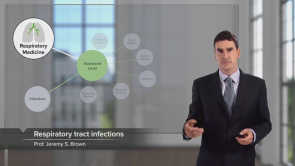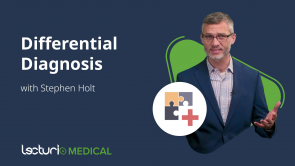Differential Diagnosis: Approach to a Patient with Hearing Loss

Über den Vortrag
Der Vortrag „Differential Diagnosis: Approach to a Patient with Hearing Loss“ von Stephen Holt, MD, MS ist Bestandteil des Kurses „Differential Diagnosis“.
Quiz zum Vortrag
Presbycusis refers to:
- Age-related hearing loss
- Inflammation of the middle ear
- Congenital hearing loss
- Temporary hearing loss due to earwax blockage
- Hearing loss due to excess noise exposure
Which differential diagnosis category does hearing loss from excessive noise exposure fall under?
- Degenerative
- Vascular
- Neoplasm
- Psychogenic
- Endocrine
In the Weber test, where is the tuning fork placed to perform the evaluation?
- On the midline of the forehead
- On the mastoid process
- On the tragus of the ear
- On the occipital bone
- On the zygomatic arch
What is the primary form of hearing loss associated with otosclerosis?
- Conductive hearing loss
- Low-frequency sensorineural hearing loss
- Mixed hearing loss
- Central auditory processing disorder
- Presbycusis
In the Rinne test, after placing the vibrating tuning fork against the patient's mastoid bone, where should it be moved next to compare air conduction and bone conduction?
- Next to the ear canal
- On the forehead
- On the zygomatic arch
- On the nasal bridge
- On the occipital bone
Kundenrezensionen
5,0 von 5 Sternen
| 5 Sterne |
|
1 |
| 4 Sterne |
|
0 |
| 3 Sterne |
|
0 |
| 2 Sterne |
|
0 |
| 1 Stern |
|
0 |
The desciptiveness of the approach is absoloutely helpful for med students to set a certain diagnosis probability cascade




